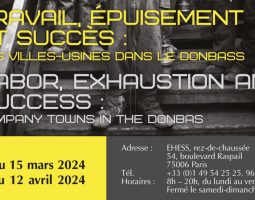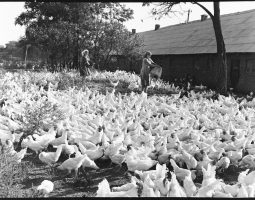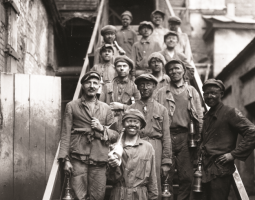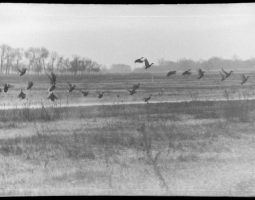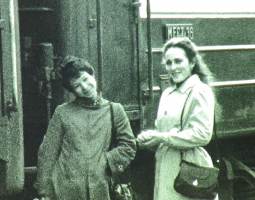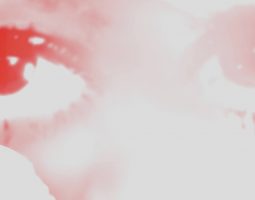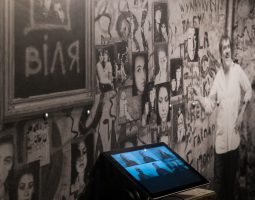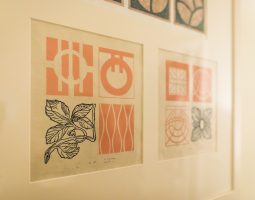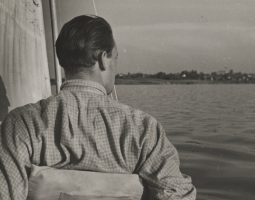
- Center for Urban History
- 6 Bohomoltsia Str. Lviv 79005, Ukraine
- Donate
Exhibitions
Exhibitions as an important format of the Center’s public history program serve to bridge communication between diverse audiences, especially between professionals and the larger public. They offer different actors the possibility to engage in the production and sharing of knowledge. Our main goal is to balance academic and public forums in order to both preserve the complexity of issues, search for a balance between design solutions and public engagement. We see exhibitions as a way to bring topics that are problematic and have contemporary relevance and a forum for critical reflection on our knowledge about the past. Choosing new, often contested topics, we attempt at expanding thematic scopes and involving new participants into conversations to develop our capacities to revisit settled views and motive for an active rethinking of the past as a part of ongoing dialogue in contemporary societies.
Our exhibitions are mostly developed by researchers working and affiliated with the Center, but we also invite guest experts to contribute to specific projects and cherish institutional cooperation developing or hosting exhibitions. Collections of our Urban Media Archive are critical for our exhibitions and support programs, including lectures, discussions, education programs and curated excursions. Over more than ten years the Center organized and took part in organizing more than fifty exhibitions. All our exhibitions are free of charge.
The inauguration of our exhibition hall in 2009 came with the exhibition “Lviv A World A Way" which was an adaptation of the original display "Wo ist Lemberg?" ("Where is Lviv?") created in Berlin by the Neue Synagoge – Centrum Judaicum. It was then adapted in Lviv to tell the story of a city inhabited by people of different communities whose identities, cultures and religions interacted with and influenced each other. The exhibition invited contemporary Lvivians to explore their home city through the story of diversity, but also through the history of destruction. As one of the visitors put it: “This is a tremendously interesting exhibition that evokes a wish to walk through the old streets of Lviv and have a new look at our home city.” The exhibition opened in October 2008 in connection with the conference on Jewish heritage emphasizing the links between public and academic.
This first larger scale experience pushed us to think about one of our exhibition strategies: addressing well-known subjects, such as Lviv for Lvivians, yet placing them in urban and broader historical contexts and thus questioning our assumptions and knowledge. Following this logic the Center's team has developed the exhibition “Eros and Sexuality: A Century of Coercion, Control, and Emancipation” examining how the emergence of modernity drove the sphere of sexuality into an era of unprecedented change, but without a simple storyline of gradual or inevitable progress. The exhibition was launched in tandem with the conference. The exploration into the cultural, social, political, and ideological contexts of homemaking in the 20th century was at the Center of “Home: A Century of Change” in 2010. For this exhibition we developed our first series of accompanying events, the program for children, and published a volume “Home: A Century of Change” that can be downloaded here. Sport was a big topic in the contexts of the 2012 UEFA Championship, jointly hosted by Ukraine and Poland. To contextualize this international sporting event, the Center prepared an exhibition, “Sport and the City: People, Society, Ideology” placing sport into historical,social, and cultural contexts and co-organized international workshop “Mega-Events in Eastern Europe.”In 2014, multiple European and global events were organized to commemorate the 100th
anniversary of the start of World War I. Within that context, the Center launched a new exhibition in December 2014 on “The Great War 1914 – ...: Individual and Global Experiences” presented diverse views on the Great War from different but connected perspectives: as a global conflict and as an individual experience.
Exhibitions are also a format to explore the possibilities and meanings of photographs in addressing the past. For example, “Boryslav through the Photos of Stanisław Rachfał” was based on images from the found album of photographs of the town of Boryslav (Borysław) and oil industry there taken in the 1920s-30s by Stanisław Rachfał and asked about the role of images in memory practices and our interpretations of amateur documentary photography. Between 2010 and 2017 the Center displayed three exhibitions by Tadeusz Rolke from Warsaw. The first “We Were Here” explored the places of Chassidic Jews history, where they lived and resided on the territories of contemporary Ukraine and Poland. The most recent “Tomorrow Will Be Better” visually revisited the stories of Lviv in the year of the collapse of the USSR, documenting the crisis, the feeling of uncertainty, but also the anticipation of change. This exhibition was an invitation for reflections in the year marking the 25 years of Ukraine’s Independence.
While most exhibitions take place on the Center’s own premises, we also partner with museums and other institutions and use the potential of open public spaces. In 2015, the Center cooperated with the Lviv National Art Gallery to jointly produce “Ketubot: Jewish Marriage Contracts.” In 2017 we were among the partners for the “Montages: Debora Vogel and the New Legend of the City” exhibition at the Muzeum Sztuki in Lodz. As the city of Lviv is the place we work and live, its spaces become instances for our research, reflections, and display venues. In a different way, the very space of the city is our partner in bringing our exhibitions closer to the city dwellers and visitors. Thus, at Katedranla Square we showed the exhibition “Informed and Broadcast by Lviv” centered around the story of Lviv as a major TV set production and a seat of regional TV and asked how watching TV shaped both the ways of life and the ways the city was represented and imagined. Three locations for “'Searching for Home' in Postwar Lviv: The Experience of Pidzamche” allowed openings for different audiences, from the central location in the neighborhood at the Pidzamche Railway Station to the main Rynok Square in front of the City Hall. Several years later we returned to the same location with the exhibition “Labor, Exhaustion, and Success: Company Towns in the Donbas” that brought the histories of the region at the center of the ongoing war and occupation and the region for many people who had to find new homes in other cities, including in Lviv. The fence of a local school became a site for a conversation between researchers and local community members on the history of the area as a possibility to involve inhabitants in planning and decision making. The poster exhibition “Novyi Lviv: Amongst Parks and the Railway” also showed that localities can be powerful for telling larger stories as improving living standards; city-garden movement; modernist experiments in architecture; growing role of sport and self-improvement, and expanding presence of leisure and green areas in modern city. Finally, the smallest square of the city, became a site for the exhibition exploring the stories of life and the fate of Jewish inhabitants of Lviv during and after the Holocaust. “Message from the Past, Lesson for the Future” was created by the participants of the summer school "Jewish History, Multiethnic Past, and Common Heritage."
One of the most fruitful avenues we have explored in recent years was cooperation with artists in finding the ways to engage with the past. In 2016 the Center commissioned a new media art work "Resonance" created by two artists - Oleh Voronko (UA) and Jason Fiddler (UK) - for the opening of the Space of Synagogues in front of the remains of the Golden Rose Synagogue. Following year, a media artwork was created as a part of the [unarchiving] program and became a regular part of our Public History program in general. In 2017, the Center created “(un)named” exhibition in cooperation with an artist Nikita Kadan and a group of researchers to reflect on the ways of engaging with the mass violence in the past. Vlodko Kostyrko contributed with his art installation to our 2020 exhibition about archiving and researching the 1980s-90s photographic practices in Lviv. Such avenues for cooperation proved to be especially inspiring for critical reflections and visual communication.
